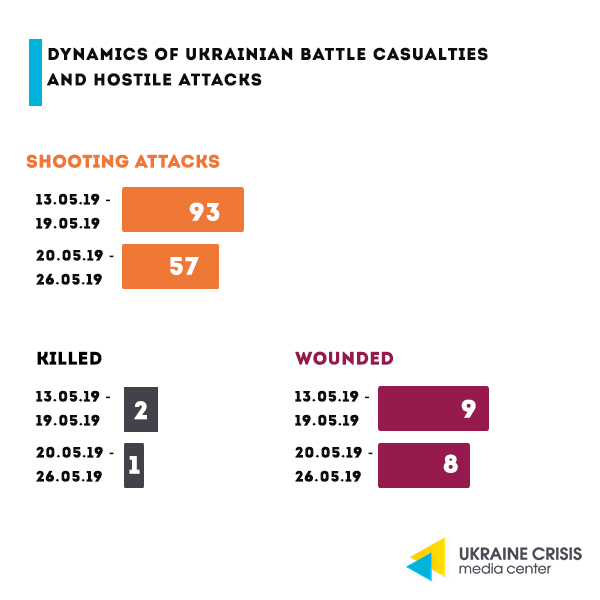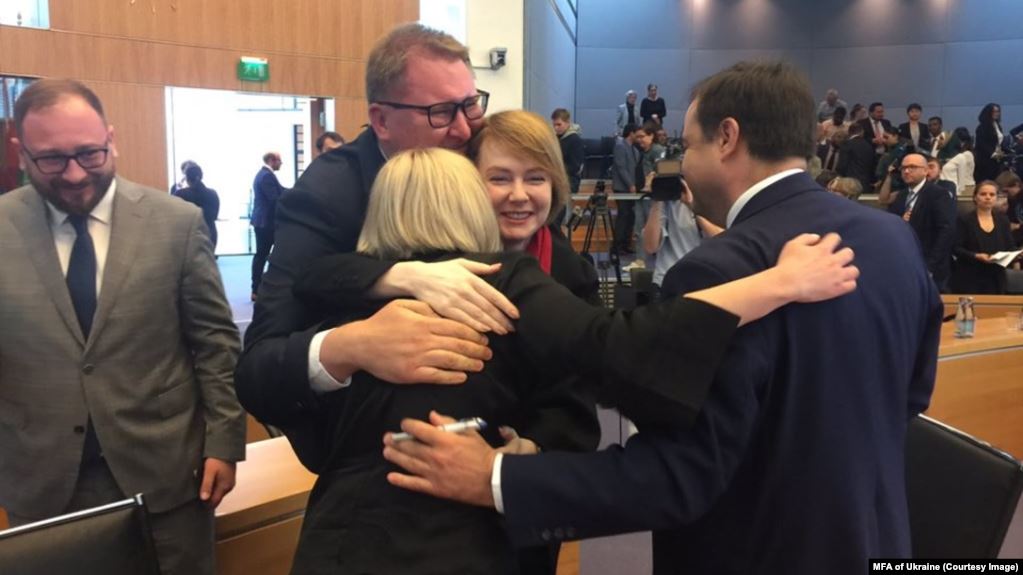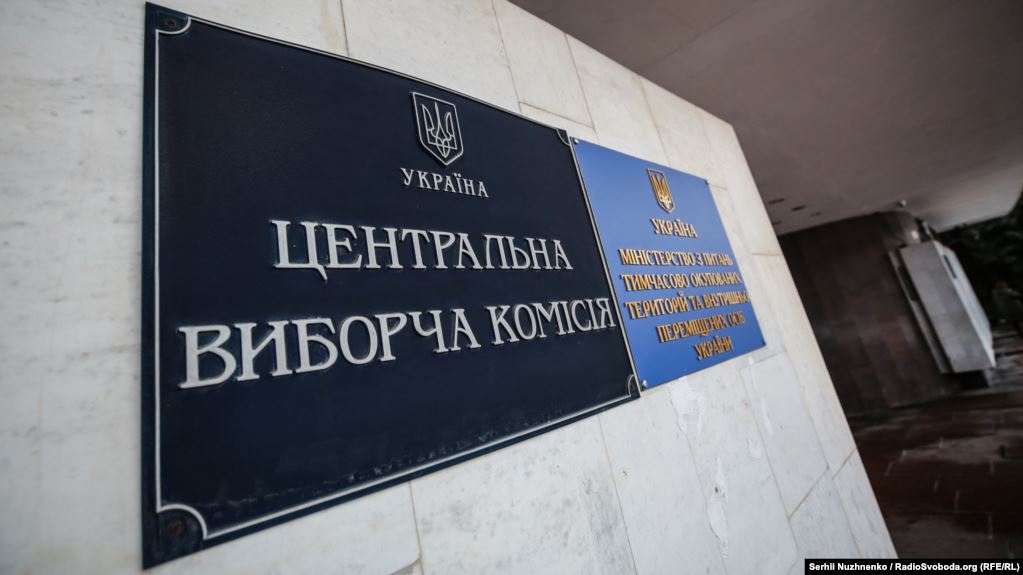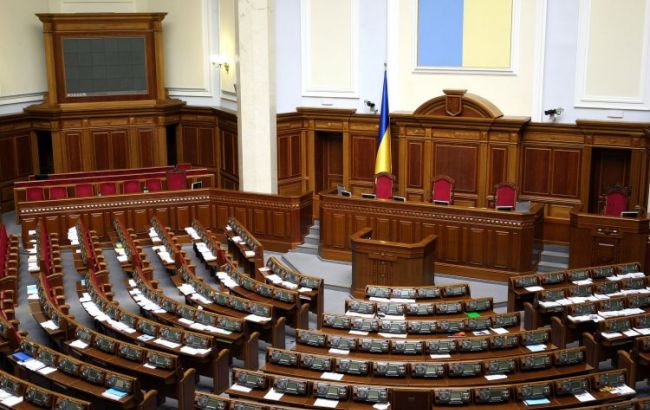Situation in the combat zone

Russia-backed militants kept violating the ceasefire using the Minsk-proscribed 82-mm mortars. They also fired upon the Ukrainian troops from automatic grenade launchers and heavy machine guns.
On May 22 eight Ukrainian troops were captured by Russian proxies in the occupied area in Donetsk region. The servicemen were driving in a military truck near Troyitske, they possibly deviated from the planned route and drove into the occupied area where they were captured by Russia-backed militants.
International Tribunal for the Law of the Sea issues order on captured Ukrainian sailors

UN’s International Tribunal for the Law of the Sea issued an order binding the Russian Federation to free the three Ukrainian vessels and 24 Ukrainian sailors captured near the Kerch Strait in November 2018 and let them return to Ukraine. Respective order stipulating the provisional measures that coincide with what the Ukrainian side was requesting, was announced by the Judge Jin-Hyun Paik in Hamburg on May 25. “(…) the Tribunal considers it appropriate under the circumstances of the present case to prescribe provisional measures requiring the Russian Federation to release the three Ukrainian naval vessels and the 24 detained Ukrainian servicemen and to allow them to return to Ukraine,” the Judge read out.
Comment by the President Zelenskyi. President of Ukraine Volodymyr Zelenskyi is convinced that should Russia implement the order issued by the International Tribunal on the Law of the Sea and release all the captured Ukrainian sailors and vessels, it may become a clear signal that the Russian authorities are ready to stop the conflict with Ukraine. “Russian Federation implementing the order issued by the International Tribunal on the Law of the Sea requesting the release of the captured Ukrainian sailors and vessels, may become the first sign that the Russian authorities are actually ready to stop the conflict with Ukraine,” the head of the state wrote on his Facebook page on May 25.
Russia’s reaction. Russian authorities, as quoted by RIA Novosti news agency, stated that the order issued by the International Tribunal binding Russia to release the servicemen of Ukraine’s Naval Forces captured in the Black Sea is not mandatory. “If a highly-qualified judge at the International Tribunal got confused by the papers and doesn’t see anything but accusations against Russia, his words and orders are not worth a penny for us,” said Ruslan Balbek, “MP” of the illegal State Duma (Parliament) in what Russia calls “the Crimean Republic”.
Early parliamentary elections: basics

On May 24 a parliamentary election campaign started in Ukraine. The early parliamentary elections will take place on July 21. We take a look at the electoral system that will be used, political forces intending to get into the Parliament and at the possible obstacles they may encounter. Read on.
Zelenskyi’s order appealed. Several MPs of the “Narodnyi Front” (People’s Front) faction filed an appeal to the Constitutional Court of Ukraine to check if the President’s order of May 21, 2019 “On early termination of powers of the Verkhovna Rada (Ukraine’s Parliament) and on scheduling early elections” is in line with the Constitution. “As we see it, the Presidential order directly and clearly violates the rule of law principle stipulated by the Constitution,” deputy head of the faction Andriy Teteruk told journalists last Friday.
How long will it take the Constitutional Court to decide? According to the secretary of the Central Election Commission Natalia Bernatska: “The Constitutional Court considers such appeals for six months. It can also decide that the issue is of utmost importance to speed up the process and consider it in under one month,” the official told journalists on May 24. The Central Election Commission expects the Constitutional Court to issue a decision addressing the claim filed by 62 MPs requesting to check if the Presidential order is in line with Ukraine’s Constitution.
Which electoral system will be in use? During the presidential election campaign Volodymyr Zelenskyi was backing the open-list system, while what he actually introduced to the Parliament was a draft law that suggested revoking the majoritarian system to introduce the proportional system with closed lists. He also suggested to decrease the electoral threshold to three per cent. The MPs cast just 91 votes in favor and failed to include the draft into their working agenda.
So Ukraine’s next Parliament will be elected with a mixed system – the first half by closed-list proportional representation and the second half by the majoritarian system. Closed party lists will be formed at the party congresses, while majoritarian candidates can be either independent or represent a political force. The areas outside of the governmental control will obviously not be part of the election process, these are nine election districts in Donetsk region, five in Luhansk region and 12 in the Autonomous Republic of Crimea and in Sevastopol.
Election threshold at the upcoming elections is five per cent. Political blocs cannot be formed.
Which parties will be competing for seats in the Parliament? The two grand players of Ukraine’s politics – Petro Poroshenko Bloc and Batkivshyna All-Ukrainian Union, stated they are ready for the early elections. “Samopomich” will also campaign. According to Andriy Sadovyi, the party head, the list will be renewed by 70 per cent.
“Narodnyi Front” and “Oleh Lyashko’s Radical Party” are also participating in the election race. The “Opposition Bloc” is also campaigning, MP and party member Dmytro Kolesnikov said his party has no populists but experienced professionals instead and that they are ready “to restore peace”.
Opinion polling: what are the chances of parties at the parliamentary elections?

Rating group held an opinion poll in all Ukraine’s region but Crimea and temporarily occupied areas in Donetsk and Luhansk regions between May 16 and 21. Results of the poll show that Zelenskyi’s “Sluha Narodu” (People’s Servant) party ranks first, 43,8 per cent of those who are going to vote and made up their mind will vote for it.
Second most popular choice is “Opposition Paltform – Za Zhyttia (For Life)” with 10,5 per cent of voters’ support. Third place is with the “Petro Poroshenko Bloc – Solidarnist (Solidarity)” that scores 8,8 per cent.
The five-per cent threshold can be overcome by five parties:
- “Sluha Narodu” – 43,8 per cent with those who will vote and have chosen the party (33,3 per cent of all voters)
- “Opposition Platform – Za Zhyttia” – 10,5 per cent (8,1 per cent)
- “Petro Poroshenko Bloc – Solidarnist” – 8,8 per cent (6,4 per cent)
- “Batkivshyna” – 7,3 per cent (5,5 per cent)
- “Syla i Chest” (Strength and Honor) of Ihor Smeshko – 5,1 per cent (3,8 per cent)
Three more forces may well overcome the threshold should it be decreased by three per cent:
- Svyatoslav Vakarchuk’s party – 4,6 per cent (3,4 per cent)
- Radical Party – 3,3 per cent (2,5 per cent)
- Opposition Bloc – 3,2 per cent (2,4 per cent)
According to the Ranking group, all other political forces score less than three per cent.





